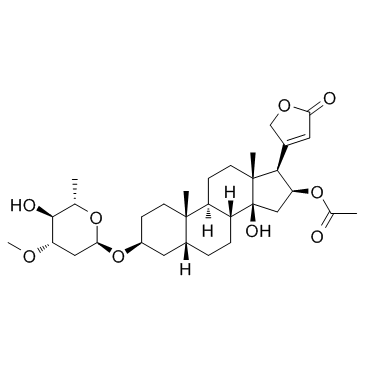Oleandrin

Oleandrin structure
|
Common Name | Oleandrin | ||
|---|---|---|---|---|
| CAS Number | 465-16-7 | Molecular Weight | 576.718 | |
| Density | 1.26 | Boiling Point | 693.7±55.0 °C at 760 mmHg | |
| Molecular Formula | C32H48O9 | Melting Point | 250ºC | |
| MSDS | Chinese USA | Flash Point | 217.2±25.0 °C | |
| Symbol |


GHS06, GHS08 |
Signal Word | Danger | |
|
Rapid detection of convallatoxin using five digoxin immunoassays.
Clin. Toxicol. (Phila.) 52(7) , 659-63, (2014) Cardiac glycosides of plant origin are implicated in toxic ingestions that may result in hospitalization and are potentially lethal. The utility of commonly available digoxin serum assays for detecting foxglove and oleander ingestion has been demonstrated, bu... |
|
|
PBI-05204, a supercritical CO₂ extract of Nerium oleander, inhibits growth of human pancreatic cancer via targeting the PI3K/mTOR pathway.
Invest. New Drugs 33(2) , 271-9, (2015) Introduction Oleandrin, a cardiac glycoside, exerts strong anti-proliferative activity against various human malignancies in in vitro cells. Here, we report the antitumor efficacy of PBI-05204, a supercritical C0₂ extract of Nerium oleander containing oleandr... |
|
|
BDNF mediates neuroprotection against oxygen-glucose deprivation by the cardiac glycoside oleandrin.
J. Neurosci. 34(3) , 963-8, (2014) We have previously shown that the botanical drug candidate PBI-05204, a supercritical CO2 extract of Nerium oleander, provides neuroprotection in both in vitro and in vivo brain slice-based models for focal ischemia (Dunn et al., 2011). Intriguingly, plasma l... |
|
|
Cytotoxic effects of cardiac glycosides in colon cancer cells, alone and in combination with standard chemotherapeutic drugs.
J. Nat. Prod. 72 , 1969-74, (2009) Cardiac glycosides have been reported to exhibit cytotoxic activity against several different cancer types, but studies against colorectal cancer are lacking. In a screening procedure aimed at identifying natural products with activity against colon cancer, s... |
|
|
Unexpectedly dangerous escargot stew: oleandrin poisoning through the alimentary chain.
J. Anal. Toxicol. 30(9) , 683-6, (2006) A female, aged 43 and a male, aged 66, experienced gastrointestinal and cardiovascular symptoms after a meal including snail stew. Twelve hours after the ingestion, they presented with nausea, vomiting, diarrhea, and cardiovascular symptoms typical of acute t... |
|
|
Oleandrin produces changes in intracellular calcium levels in isolated cardiomyocytes: a real-time fluorescence imaging study comparing adult to neonatal cardiomyocytes.
J. Toxicol. Environ. Health A 70(6) , 568-74, (2007) Oleanders are common, hardy shrubs that grow throughout the southern United States. They contain cardiotonic steroids formed from cardenolides and bufadienolides, making the plant poisonous to both animals and humans. Aliquots of both commercially available o... |
|
|
In vitro study of the effectiveness of three commercial adsorbents for binding oleander toxins.
Clin. Toxicol. (Phila.) 47(3) , 213-8, (2009) Oleander (Nerium oleander) poisoning is a common problem found in many parts of the world. The oleander toxicity is due to oleandrin and its aglycone metabolite oleandrigenin. Activated charcoal is a useful gastrointestinal decontamination agent that limits t... |
|
|
The new enzyme-linked immunosorbent digoxin assay on the ADVIA Integrated Modular System is virtually free from oleander interference.
Ther. Drug Monit. 28(2) , 282-5, (2006) Despite known toxicity of oleander, this product is used in herbal preparations. Oleander interferes with various digoxin immunoassays. It is possible that a person taking digoxin also may take oleander-containing herbal products, and digoxin immunoassays int... |
|
|
Nerium oleander derived cardiac glycoside oleandrin is a novel inhibitor of HIV infectivity.
Fitoterapia 84 , 32-9, (2013) We evaluated the effectiveness of Anvirzel™, an aqueous extract of Nerium oleander on HIV infection of human peripheral blood mononuclear cells. Oleandrin, the principle cardiac glycoside (CG) in Anvirzel™ has been shown to exhibit anti-cancer properties but ... |
|
|
Stability of oleander extract and oleandrin in sera stored in plastic serum separator tubes.
Ann. Clin. Biochem. 44(Pt 5) , 485-7, (2007) Oleander poisoning is common in the southern parts of the United States as well as part of Europe and South East Asia. The fluorescence polarization immunoassay (FPIA) for digoxin cross-reacts with oleandrin, the major poison of oleander extract and can be us... |